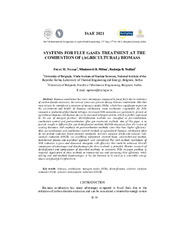Prikaz osnovnih podataka o dokumentu
SYSTEMS FOR FLUE GASES TREATMENT AT THE COMBUSTION OF (AGRICULTURAL) BIOMASS
| dc.creator | Petrov, Nevena | |
| dc.creator | Mladenović, Milica R. | |
| dc.creator | Rudonja, Nedžad | |
| dc.date.accessioned | 2023-03-05T20:54:51Z | |
| dc.date.available | 2023-03-05T20:54:51Z | |
| dc.date.issued | 2021 | |
| dc.identifier.isbn | 978-86-7834-386-5 | |
| dc.identifier.uri | https://machinery.mas.bg.ac.rs/handle/123456789/5231 | |
| dc.description.abstract | Biomass combustion has many advantages compared to fossil fuels due to reduction of carbon dioxide emissions, but several issues are present during biomass combustion. One that must always be considered is emission of nitrogen oxides (NOx), which have significant impact on the environment and health. At biomass combustion, main mechanism responsible for NOx emission is oxidation of fuel-bound nitrogen. Increased NOx emissions are particularly present at agricultural biomass combustion, due to its increased nitrogen content, which is further expressed by the use of nitrogen fertilizer. Denitrification methods are classified as pre-combustion, combustion control and post-combustion (flue gas treatment) methods. Aim of this paper is to provide insight in different flue gas denitrification methods (DeNOx measures) from the review of existing literature, with emphasis on post-combustion methods, since they have higher efficiency. Also, pre-combustion and combustion control methods at agricultural biomass combustion often do not provide reduction below emission standards. Selective catalytic (SCR) and selective noncatalytic reduction (SNCR), wet scrubbing, adsorption, electron beam, electrochemical method, non-thermal plasma and microbial approach were considered. For each method, mechanism of NOx reduction is given and discussed, alongside with efficiency that could be achieved. Overall comparison of advantages and disadvantages for these methods is provided. Further research of denitrification and optimization of described methods, to overcome NOx emission problem is required. Application of these methods in commercial use and increasing their efficiency, while solving cost and methods disadvantages, is key for biomass to be used as a renewable energy source and fossil fuel replacement. | sr |
| dc.language.iso | en | sr |
| dc.publisher | University of Belgrade, Faculty of Agriculture, Serbia. | sr |
| dc.relation | info:eu-repo/grantAgreement/MESTD/inst-2020/200017/RS// | sr |
| dc.relation | info:eu-repo/grantAgreement/MESTD/inst-2020/200105/RS// | sr |
| dc.rights | openAccess | sr |
| dc.rights.uri | https://creativecommons.org/licenses/by/4.0/ | |
| dc.source | Proceedings of The Fifth International Symposium on Agricultural Engineering ISAE-2021 | sr |
| dc.subject | biomass | sr |
| dc.subject | combustion | sr |
| dc.subject | nitrogen oxides (NOx) | sr |
| dc.subject | denitrification | sr |
| dc.subject | selective catalytic reduction (SCR) | sr |
| dc.subject | selective non-catalytic reduction (SNCR) | sr |
| dc.title | SYSTEMS FOR FLUE GASES TREATMENT AT THE COMBUSTION OF (AGRICULTURAL) BIOMASS | sr |
| dc.type | conferenceObject | sr |
| dc.rights.license | BY | sr |
| dc.citation.epage | III-39 | |
| dc.citation.rank | M33 | |
| dc.citation.spage | III-30 | |
| dc.identifier.fulltext | http://machinery.mas.bg.ac.rs/bitstream/id/12740/bitstream_12740.pdf | |
| dc.identifier.rcub | https://hdl.handle.net/21.15107/rcub_machinery_5231 | |
| dc.type.version | publishedVersion | sr |


